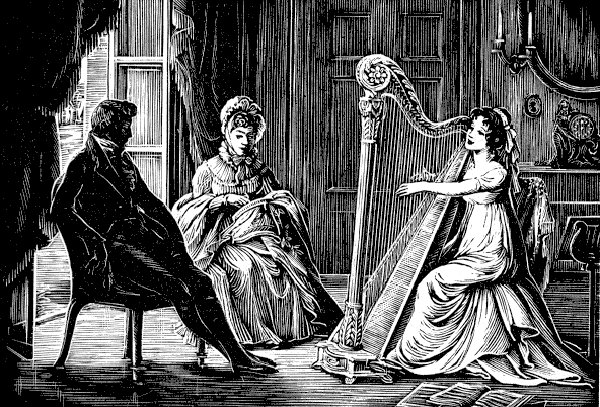Why have we had a Jane Austen revival? Why do we remain fascinated with 200-year-old novels in which nothing much happens but drawing-room conversations and emotional detective work by women to figure out the intentions of men? Partly, I’m sure, the answer to that is the BBC. We can’t get enough of those BBC costume dramas, those lavish sets, those charismatic young English actors and actresses. I’ll argue, though, that reading Jane Austen, for some mysterious reason, is more entertaining than the BBC productions.
It had been more than 30 years since I’d read Jane Austen, so I’ve had a bit of a Austen marathon during the last month. First I read Sense and Sensibility, then Pride and Prejudice. Then I watched the 2009 BBC production of Emma with Romola Garai. How many versions of Emma have we seen? Still, we’re always ready for a remake.
Many readers today probably find Austen difficult to read. Her sentences are long and tangled. Though her world is a world of strict and repressive rules, if she has a rule for using commas, I don’t know what it is, unless it’s that long sentences must have lots of them, with some semicolons mixed in for variety. Some new editions include notes to help modern readers understand some of the references to elements of culture that are now lost. For example, my 2003 Barnes and Noble edition of Pride and Prejudice includes notes from a scholar. But on the very first page this scholar proves that she doesn’t know as much as she thinks she knows. Jane Austen writes (Mrs. Bennet is speaking):
“Why, my dear, you must know, Mrs. Long says that Netherfield is taken by a young man of large fortune from the north of England; that he came down on Monday in a chaise and four to see the place, and was so much delighted with it that he agreed with Mr. Morris immediately; that he is to take possession before Michaelmas, and some of his servants are to be in the house by the end of next week.”
This sentence, the scholar deems, requires two notes: One is to tell us that a chaise and four is “a four-wheeled closed carriage.” I laughed out loud, because this is very wrong. A chaise and four is a carriage pulled by four horses. Anyone of Jane Austen’s time would have known that a carriage carrying a single person pulled by four horses means either or both of two things: That the person is rich, or he is in a hurry. The second scholarly note tells us that Michaelmas is the feast of St. Michael, celebrated on Sept. 29. Michaelmas also marked the end of summery weather.
That Sense and Sensibility was Jane Austen’s first novel (1811) is, I think, evident in a certain lack of confidence in her writing style and an unevenness in her sense of drama. For example, she pulls off a stunning piece of drama in one place, but misses the opportunity in another. Near the end, Marianne falls ill while she and Elinor are traveling and staying at the home of a friend. Marianne takes a turn for the worse, and Elinor fears that the situation is so grave that she sends for their mother to come in all haste. In the dark of night, a carriage (drawn by four horses!) comes roaring up to the house, and Elinor assumes it is their mother. But actually it is Willoughby, who has heard of Marianne’s illness and who comes to say that he has loved Marianne all along. Contrast this high drama with the book’s climax, when Edward reveals to Elinor that it is she he loves after all, but without a bit of drama.
No film version of these novels can reconnect us with our lost culture (and lost powers of the English language) the way the books can. We seem to realize that something important is missing in our post-industrial lives, but we’re not sure what. And how could we know, without some research? These classic novels help to remind us of what was lost when we went to work in factories and paved the world.
As an example of the loss of a picturesque element of culture: In chapter 7 of Sense and Sensibility, Sir John Middleton decides to have a party on short notice:
He hoped they would all excuse the smallness of the party, and could assure them it should never happen so again. He had been to several families that morning in hopes of procuring some addition to their number, but it was moonlight and every body was full of engagements.
These days we hardly ever notice the moon. Once upon a time, our social lives revolved around it, because those carriages (and poorer people on foot) could move around much more safely and conveniently in the moonlight.
We traded our moonlight for headlights and street lights. What a sorry deal.


I had no idea what a “chaise and four” was or why it was used. But!, now I do, thanks it makes the story better, I think. I did not know of the Feast of St Michael, I was born in San Francisco, and we kicked the can during moonlit nights. I remember one moon less night while running very fast near my grandparents home in the country, I was stopped very suddenly with a whoosh of loosing my breath and falling backwards stunned, crying laughing for my brothers, realizing I hit the mailbox in full stride! I have to admit I am fascinated by the TV productions. I have a friend from ElSalvador who writes to me about them, it seems his neighbors watch the serials too.